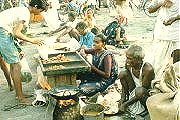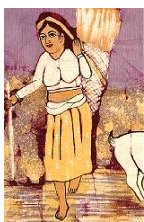

Nepal 
 |
Wood Energy Situation Policies and Programmes Wood Energy Data Further Reading RWEDP Focal Points |
Wood Energy Situation
Woodfuels accounted for 69% and biomass for 92% of Nepal's total energy consumption in 1993-4. Woodfuels play a very important role in domestic cooking and space heating. The demand for fuelwood in the country has rapidly increased due to population growth, and has resulted in tremendous pressure on existing forests.
Fuelwood originates from public forests, shrub and grasslands and private holdings. Nepal has an estimated 8.85 Mha of potentially productive forests, shrub and grasslands, of which 6.73 Mha are estimated to be forests and scrubland only, and about 50% of the later is used for fuelwood collection. Of the estimated total sustainable yield of 17.5 million tons of fuelwood, 6 million tons is accessible. Agricultural residues constitute some 14.9% of energy consumption and about 4% of the long-term theoretical indigenous energy potential of Nepal. In 1985/86 total production of crop residues was estimated at 12.5 million tons, of which 67.4% is rice straw. At present most of the agricultural residues are burned in open fires. Dung constituted 8.2% of energy consumption.
Policies and Programmes
The government of Nepal has always given its concerns to wood energy development. With the efforts from RWEDP, wood energy issues has been placed firmly into the country's policy and planning. The current five-year plan (1992-1997) states that one of the main objectives of forestry sector development is "stability of supply of timber, fuelwood, fodder and other forestry products necessary for common people in their daily life". The Forestry Sector Master Plan, prepared in 1988, realised the importance of wood energy planning. The document clearly identified the imbalance between fuelwood supply and demand and suggested methods for augmenting woodfuel supplies. Emphasis was given to community forestry development.
 Nepal now has a wealth of data on wood energy and rural energy supply and demand. An energy pricing study has also been implemented which contains a woodfuel flow study in Kathmandu Valley. A Perspective Energy Plan was completed in 1995, incorporating wood and biomass energy as one of the five components. The plan paid special attention to wood energy planning, realising that a reduction in wood energy consumption was not feasible in the foreseeable future. The results are now being incorporated in the Ninth Five-Year Plan. Furthermore, quite a number of detailed case studies have been undertaken in districts and villages, adding to a general understanding of local wood energy issues. It seems that the current needs of the country with regard to wood energy are in implementation and in strengthening local capacities. Professor M. R. Pandey, a Royal Cardiologist and president of the Nepal Heart Founder, has led a research study on the health problems of women and children caused by the use of biomass in cooking and heating. Four main health effects can be caused by domestic smoke pollution, e.g. respiratory diseases and cor pulmonale, adverse pregnancy outcomes, cancer, and eye problems.
Nepal now has a wealth of data on wood energy and rural energy supply and demand. An energy pricing study has also been implemented which contains a woodfuel flow study in Kathmandu Valley. A Perspective Energy Plan was completed in 1995, incorporating wood and biomass energy as one of the five components. The plan paid special attention to wood energy planning, realising that a reduction in wood energy consumption was not feasible in the foreseeable future. The results are now being incorporated in the Ninth Five-Year Plan. Furthermore, quite a number of detailed case studies have been undertaken in districts and villages, adding to a general understanding of local wood energy issues. It seems that the current needs of the country with regard to wood energy are in implementation and in strengthening local capacities. Professor M. R. Pandey, a Royal Cardiologist and president of the Nepal Heart Founder, has led a research study on the health problems of women and children caused by the use of biomass in cooking and heating. Four main health effects can be caused by domestic smoke pollution, e.g. respiratory diseases and cor pulmonale, adverse pregnancy outcomes, cancer, and eye problems.
Many of the named studies and plans were initiated and supervised by the Water and Energy Commission Secretariat (WECS) and competent Nepalese staff have been actively involved. Whenever necessary, contributions from the forestry sector were requested by WECS. It is also to be noted that WECS has an articulate gender policy, formulated in "Guidelines for the Incorporation of Gender Issues in the Water and Energy Sectors" (1995).
So far, many experiences with stove dissemination have not been successful. In 1995, RWEDP provided support for two local NGOs (RECAST and CRT) for new pilot stove dissemination projects.
Nepal hosts the International Centre for Integrated Mountain Development (ICIMOD) which is an RWEDP partner with regard to co-operation in wood energy development in the Hindu-Kush-Himalaya region.
Wood Energy Data
| General | |||||
| Population (1996) | 22 mln. | ||||
| Share of Rural Population | 85.7% | ||||
| GDP per capita (1995) in constant 1987 US$ | 199 | ||||
| Energy Consumption (1995/96) | |||||
| Total Final Energy Consumption in PJ | 292.3 | ||||
| Consumption of Wood Energy in PJ | 235.5 | (80.6%) | |||
| Consumption of Biomass Energy in PJ | 263.6 | (90.2%) | |||
| Wood Energy Resources | |||||
| Forest Area (1995) in 1000 ha | 4,822 | (33.7%) | |||
| Natural Forest Area (1995) in 1000 ha | 4,766 | (33.3%) | |||
| Agricultural Area (1994) in 1000 ha | 4,509 | (31.5%) | |||
| Share of Woodfuels from Forest Areas (1995/96) | 73% | ||||
| Potential Wood Energy Supply (1994) | |||||
| Sust. Supply from Natural Forest in kton | 3,990 | ||||
| Sust. Supply from Forest Plantations in kton | 199 | ||||
| Sust. Supply from Agriculture Areas in kton | 2,608 | ||||
| Sust. Supply from Other Wooded Land in kton | 390 | ||||
| Supply from Wood Waste from Deforestation in kton | 4,258 | ||||
| Total Potential Supply in kton | 11,444 | ||||
| Primary Wood Energy Requirements in kton | 12,787 | ||||
Notes:
Population and land use data from FAO (FAOSTAT), GDP per capita from World Bank. Energy consumption data from various sources.
Potential wood energy supply estimated by RWEDP, based on available data for land use, wood productivity and estimates on availability of wood for energy use. For forest land, other wooded land and agriculture areas, the potential supply is based on average annual yield estimates, assuming a sustainable use of resources (Sust.: sustainable). Wood waste from deforestation refers to wood potentially available from natural forest land cleared due to commercial logging, expansion of agriculture land or other reasons. The estimates are based on aggregated national data, which can hide local variations, ranging from scarcity to abundance. For detailed calculations and estimates for 2010, see FD50, chapter 8
Further reading:
| Regional Study on Wood Energy Today and Tomorrow in Asia, Field Document 50, 1997 | |
| Chapter 11 in Review of Wood Energy Data in RWEDP Member Countries, Field Document 47, 1997 | |
| Oak - Production, Management and Use in the Himalayas Field Documents No. 27, 1991 | |
| Part II "Wood Energy Flows, RRA Study in Pokhara, Nepal" in Woodfuel Flows, Rapid Rural Appraisal in Four Asian Countries, Field Document 26, 1991 | |
| Wood Based Energy System in Rural Industries and Village Applications - Nepal, Field Document 11, 1988 |
Focal points are the main contacts for RWEDP in a member country. Generally, in each country, there is one focal point in the energy sector, and one in the forestry sector.
| Executive Secretary Water and Energy Commission Secretariat, Ministry of Water Resources, P. O. Box 1340 Singh Durbar, Kathmandu TEL: 977-1-27968 FAX: 977-1-227185 | Director General Forest Department Kathmandu TEL: 977-1-222321 FAX: 977-1-226099 |
Comments, questions? webmaster@rwedp.org
© FAO-RWEDP, 1999